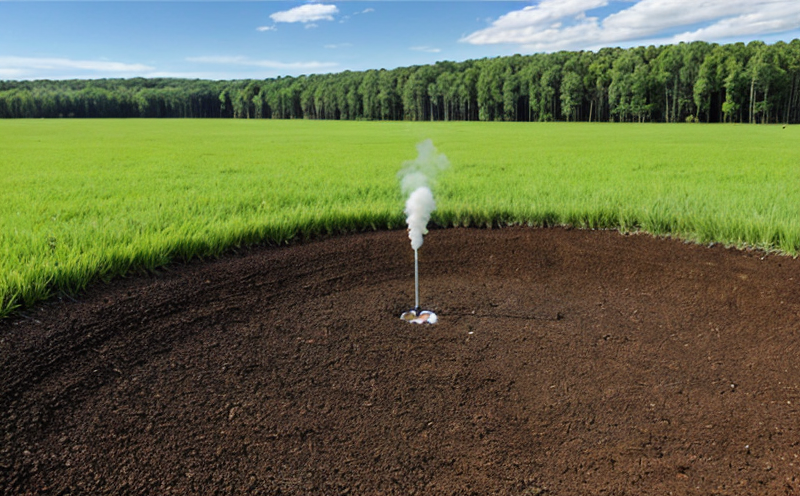EPA 1311 Toxicity Characteristic Leaching Procedure Testing for Mining Waste
The EPA 1311 toxicity characteristic leaching procedure (TCLP) is a standardized test designed to determine if hazardous waste contains certain toxic metals that may leach into the environment. This test, specified in EPA Method 1311, is crucial for mining waste management and compliance with environmental regulations.
The primary goal of this testing procedure is to ensure that mining wastes do not pose a threat to the environment when they leach into soil, groundwater, or surface waters. This is particularly important in the mining sector where various metals like arsenic, cadmium, chromium, lead, and mercury are common. Understanding the potential for these elements to contaminate water supplies through leaching can help mining companies comply with environmental laws and protect public health.
The test involves placing a sample of solid waste or sludge into a leachate solution and incubating it under controlled conditions. After 18 hours, the leachate is analyzed for metal concentrations. If the concentration exceeds certain thresholds specified by EPA Method 1311, the waste can be classified as hazardous.
Compliance with this regulation ensures that mining companies are responsible stewards of the environment and uphold public safety standards. This testing method provides a clear metric for assessing whether mining activities have a significant impact on the surrounding ecosystem or water supplies. By adhering to these standards, companies can mitigate risks and avoid potential legal penalties.
The procedure is not only critical for regulatory compliance but also for risk management. Mining companies that implement this test proactively demonstrate their commitment to sustainable practices. Understanding leaching characteristics helps in designing better containment systems, reducing the likelihood of accidental contamination, and improving overall environmental performance.
Why It Matters
The EPA 1311 toxicity characteristic leaching procedure testing is essential for several reasons:
- Regulatory Compliance: Mining waste must meet specific criteria to avoid being classified as hazardous. Non-compliance can result in significant fines and penalties.
- Environmental Protection: Ensuring that toxic metals do not leach into the environment reduces the risk of contamination, safeguarding nearby water bodies and ecosystems.
- Risk Management: Understanding potential risks allows for proactive measures to mitigate them. This can include better waste management practices and containment strategies.
- Sustainability: Compliance with such tests reflects a company's commitment to sustainable mining practices, enhancing its reputation among stakeholders.
The procedure is also important because it provides actionable data that informs decision-making processes within the mining sector. By identifying potential hazards early on, companies can implement necessary changes to their waste management protocols, thereby minimizing long-term environmental impacts.
Scope and Methodology
| Test Sample | Leachate Solution Composition | Incubation Duration | Analysis Method |
|---|---|---|---|
| Mining waste or sludge | Acidified distilled water (pH 2) | 18 hours at room temperature | Inductively coupled plasma mass spectrometry (ICP-MS) |
| Acceptance Criteria for Toxic Metals | Metal | Threshold Concentration (mg/L) |
|---|---|---|
| Pb | Cadmium | 5 |
| Arsenic | Copper | 1.3 |
| Zinc | Hazardous Waste Determination | 0.5 |
The EPA 1311 test involves placing a sample of mining waste or sludge into an acidic leachate solution (pH 2) and incubating it for 18 hours at room temperature. After the incubation period, the leachate is analyzed using inductively coupled plasma mass spectrometry (ICP-MS) to determine metal concentrations.
The acceptance criteria for toxic metals are critical in determining whether a waste can be classified as hazardous. For example, if cadmium or lead concentrations exceed 5 mg/L, or if any other listed metal exceeds its threshold concentration, the waste is considered hazardous under EPA regulations.
Quality and Reliability Assurance
- Standard Operating Procedures: Strict adherence to standard operating procedures ensures consistent results across all tests. This includes precise sample preparation, accurate leachate solution composition, and careful incubation conditions.
- Calibration of Instruments: Regular calibration of analytical instruments is essential for reliable data collection. All equipment used in the test must be calibrated against national or international standards (e.g., ISO 17025).
- Data Validation: Data from multiple independent tests are cross-validated to ensure accuracy and reliability.
The quality assurance process also involves regular audits of testing protocols by qualified personnel. These audits ensure that all steps in the procedure are followed correctly, reducing the risk of errors or inconsistencies in test results.





